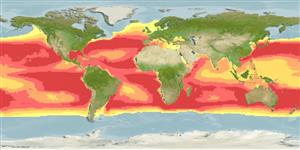Classification / Names
Common names from other countries
Main reference
Size / Weight / Age
Max length : 455 cm FL male/unsexed; (Ref. 40637); common length : 300 cm TL male/unsexed; (Ref. 9354); max. published weight: 650.0 kg (Ref. 4689)
Length at first maturity
Lm 221.0, range 156 - 250 cm
Environment
Marine; pelagic-oceanic; oceanodromous (Ref. 51243); depth range 0 - 800 m (Ref. 9354), usually 0 - 550 m (Ref. 54934)
Climate / Range
Temperate; 5°C - 27°C (Ref. 43), preferred 27°C (Ref. 107945); 61°N - 50°S, 180°W - 180°E (Ref. 54934)
Distribution
Atlantic, Indian and Pacific: tropical and temperate and sometimes cold waters, including the Mediterranean Sea, the Sea of Marmara, the Black Sea, and the Sea of Azov. Highly migratory species, Annex I of the 1982 Convention on the Law of the Sea (Ref. 26139). Mt DNA restriction analysis reveal that genetic differentiation occurs between populations inhabiting the Mediterranean Sea and the tropical Atlantic ocean, indicating little genetic exchange occurring between the two (Ref. 12784).
Countries | FAO areas | Ecosystems | Occurrences | Introductions
Short description
Dorsal
spines
(total): 0;
Dorsal
soft rays
(total): 38-56;
Anal
spines: 0;
Anal
soft rays: 16 - 18. Blackish-brown fading to light-brown below; 1st dorsal fin with blackish-brown membrane, other fins brown or blackish-brown (Ref. 43). A long, flat, sword-like bill and no pelvic fins (Ref. 26938).
IUCN Red List Status (Ref. 115185)
Human uses
Fisheries: commercial; gamefish: yes
Tools
Special reports
Download XML
Internet sources
Estimates of some properties based on models
Phylogenetic diversity index
PD50 = 1.5000 many relatives (e.g. carps) 0.5 - 2.0 few relatives (e.g. lungfishes)
Trophic Level
4.5 ±0.2 se; Based on diet studies.
Resilience
Medium, minimum population doubling time 1.4 - 4.4 years (rm=0.076; K=0.23; tm=5-6; tmax=9)
Vulnerability
High to very high vulnerability (72 of 100)
Price category
